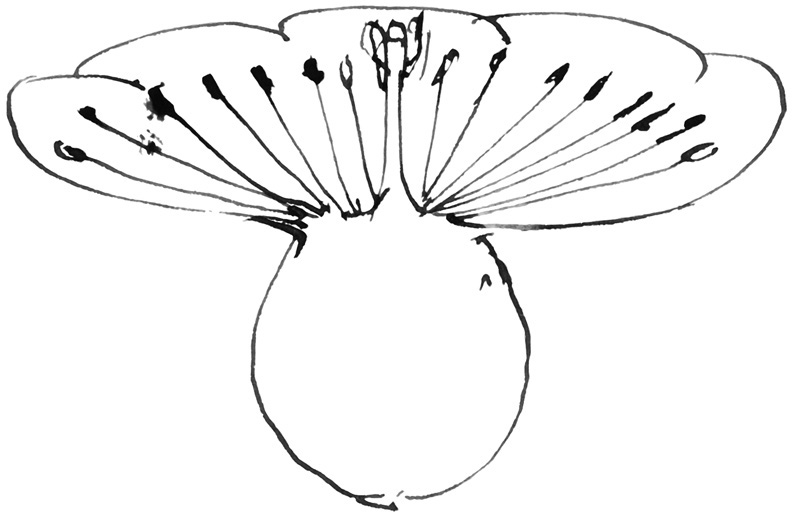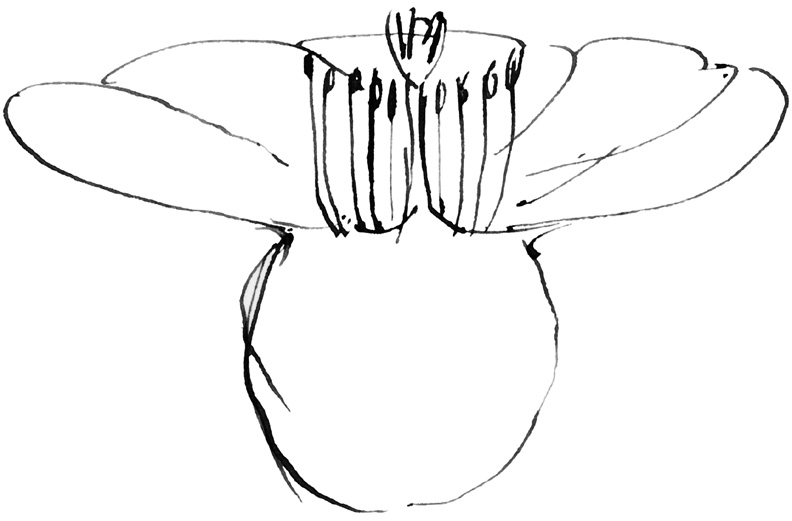From W. T. Thiselton-Dyer 31 May 1874
10 Gloucester Road, Kew
May 31. 1874
My dear Mr Darwin
Some time ago you asked me to try the effect of syringing plants with sensitive flowers.1 Opuntia is one of these and as there are a good many in flower in the Cactus house I got Mr Smith the Curator to go with me this morning and experiment upon them.2 In its so to speak virgin state the flower has the stamens spread out with a greater or less divergence from the style—

They do not use syringes with a nose at Kew but produce a spray by placing a finger over the nozzle. Mr Smith who is an adept at this and who was much interested in trying the flowers, syringed them successively.
I confess I was astonished at the readines with which the lightest syringing we could give them elicited movement. The contraction was not instantaneous but there was always a perceptible interval of time—not more than a second or so perhaps—and then the stamens gradually moved towards the style.

We tried two species in particular O. polyacantha and O. monacantha3
You asked me about Stapelias—4 I cannot find anything about movement in their flowers. I should expect the parts to be quite stationary. Probably there is some provision for cross fertilization by the removal of the pollen masses which is not yet worked out. Asclepiadaceæ are a kind of analogue amongst Dicotyledons of Orchideæ amongst Monocotyledons.5
Prof. Oliver6 called my ⟨a⟩ttention the other day to the way in which plants capture insects sometimes by means of their flowers. He had an idea that the nectar poisoned them, mentioning the Oleander as one case in point.7 Ledum palustre,8 a specimen of which I inclose, he thought was another instance. Here however it seems to me that the insects are caught by the viscidity of the ovary and according to Weale, Linn. Journ. xiii pp. 48, 49 Gomphocarpus physocarpus capture⟨d⟩ insects which “got attached to the stigmatic glands and appeared unable to release themselves”9 Of course in this way the soil above the plant would get enriched with nitrogenous matters. But I suppose that the destruction of the insects is merely an accidental concomitant of the glutinousness which is brought about in connection with some other purpose
Meehan appears to have noticed the closing of the expanded lobes of the stigma in many Scrophulariaceæ and Bignoniaceæ—. He has lately observed it in Catalpa.10 If I can keep it in my recollection when Catalpa comes into flower I will try the effects of syringing
Believe me | Yours very truly | W. T. Thiselton Dyer
CD annotations
Footnotes
Summary
Movement in plants; effect of syringing on Opuntia plants that capture insects with their flowers.
Letter details
- Letter no.
- DCP-LETT-9478
- From
- William Turner Thiselton-Dyer
- To
- Charles Robert Darwin
- Sent from
- London, Gloucester Rd, Kew, 10
- Source of text
- DAR 178: 93
- Physical description
- ALS 7pp †
Please cite as
Darwin Correspondence Project, “Letter no. 9478,” accessed on
Also published in The Correspondence of Charles Darwin, vol. 22


